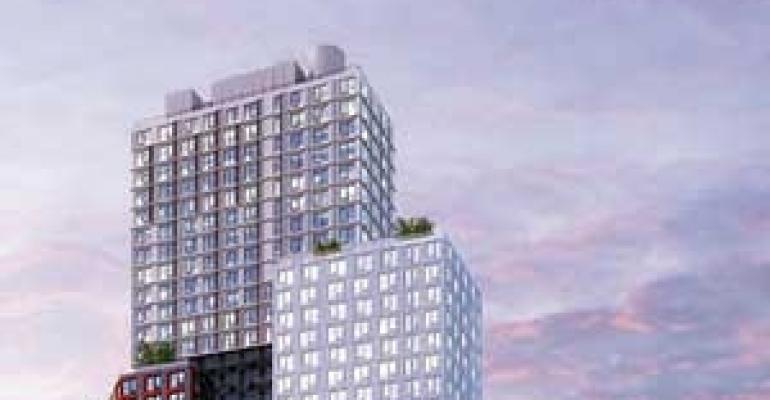The latest high-rise tower under construction in Brooklyn, N.Y., will be largely built in a factory.
Workers broke ground December 18 on B2, the first of several residential towers planned at Forest City Ratner Cos.’ (FCRC) Atlantic Yards development near Downtown Brooklyn, next to FCRC’s newly completed Barclays Center arena.
“This will be the tallest building in the world using modular technology,” says Bruce Ratner, chairman and CEO of FCRC. “And I must tell you that it will also be beautiful." The new, 32-story tower will be LEED-certified, with better air-quality and more efficient insulation than conventional construction. Modular construction techniques create this high quality of construction at a significant cost savings, according to FCRC.
So what is modular construction? The foundation and the steel framing of B2 will be built onsite, like a conventional New York City high-rise. But the interiors of B2’s 363 apartments will be constructed at a factory at the Brooklyn Navy Yard. The 930 “modules” will include entire finished rooms and sets of rooms—bedrooms with electrical outlets already installed, kitchens and bathrooms with the plumbing already in place. These “modules” will be brought to the construction site on trucks, lifted by cranes and attached to the building’s steel frame.

“This type of construction is very exciting, but what is most important, and what I care most about, is that it's affordable,” Ratner says. Overall, experts says that modular construction can chop 20 percent to 30 percent off of a development’s construction costs and increase the quality of construction at the same time.
The cost savings will help FCRC meet its promise to reserve half of the 363 apartments at B2 for households earning low, moderate and middle incomes. The remaining 182 luxury apartments will rents at market rates. The affordable and the market-rate apartments will be spread evenly throughout the tower, according to FCRC.
Construction at B2 is now expected to take 28 months, and should be finished by the end of 2014—10 months shorter than a typical construction schedule for a project of this scale, according to FCRC. That works out to an immense savings, even just considering the cost of construction financing. Modular construction can help save these 10 months because the modules that become the individual apartments can be built in a factory at the same time as construction workers at the site are still digging the foundation. They don’t have to wait till the building tops out.
"Modular promises higher quality, greener construction, faster delivery time and lower costs,” says Thomas Hanrahan, dean of Pratt's Institute's architecture school in Brooklyn. The quality can be improved by modular construction because the apartment can be finished indoors. Each module is built on a factory floor, away from the rain and weather. Modular construction is also expected to result in 70 percent to 90 percent less waste than traditional construction. B2 is expected to achieve LEED Silver certification.
In the past, labor costs have also often been part of the savings that come with modular construction. Many modular factories are located far from the more expensive labor markets on the coasts, in the hills of Pennsylvania, for example. But New York City is a town with strong construction unions, and it took some doing before they agreed to allow modular construction at B2, already settled to be a union job.
Part of the deal included a pledge that the modules would be created in a 100,000-sq.-ft. factory located in the Brooklyn Navy Yard. By late spring, 125 union workers should be employed at the factory. FCRC plans to partner with Skanska USA, one of the world’s largest construction and development groups, to create a new company called FC + Skanska Modular LLC (FCS Modular) that will build the modular components.
“With our new partner, Skanska USA, we are creating a new industry for which we can say, ‘Made in Brooklyn,” Ratner says.

